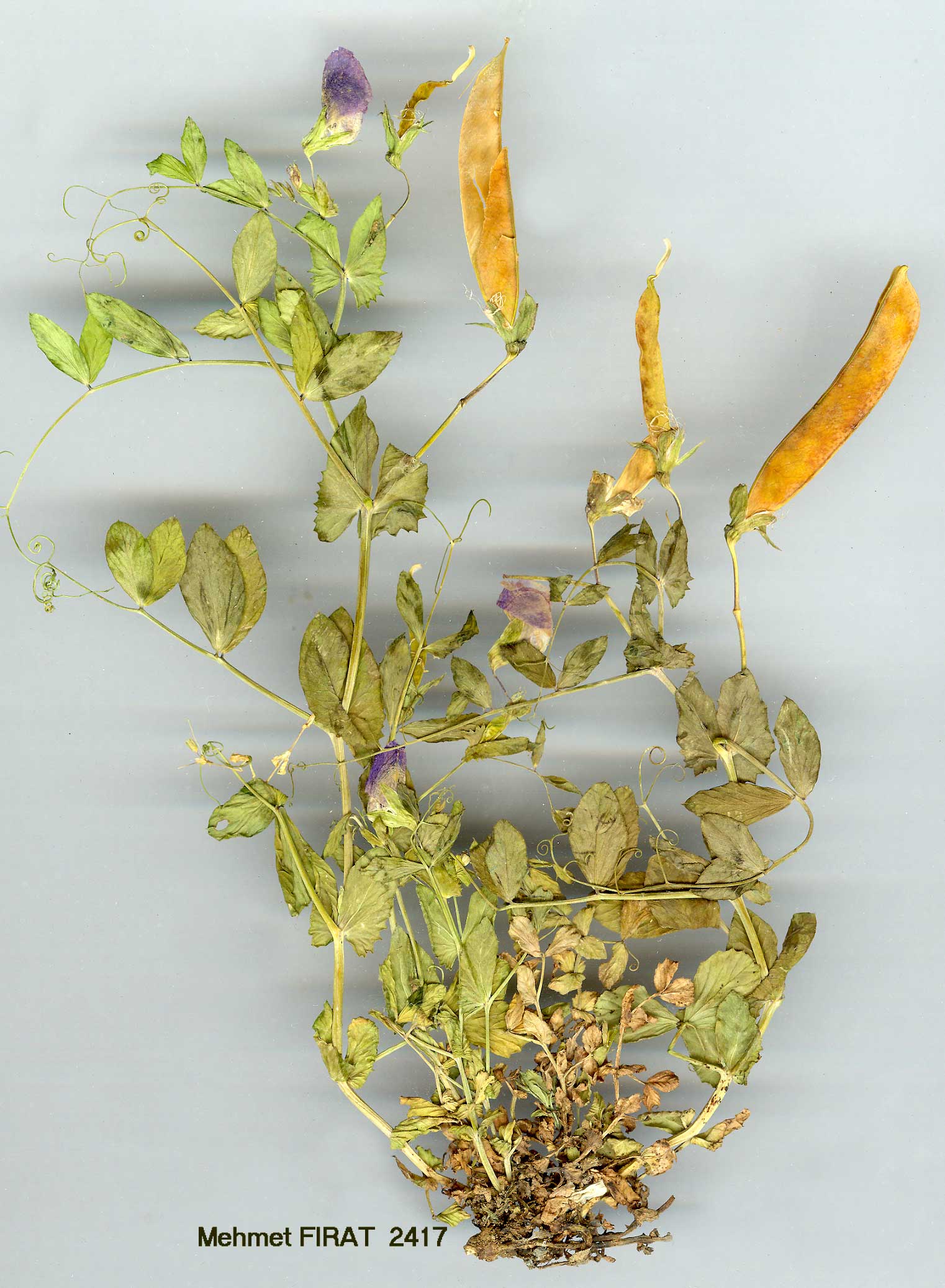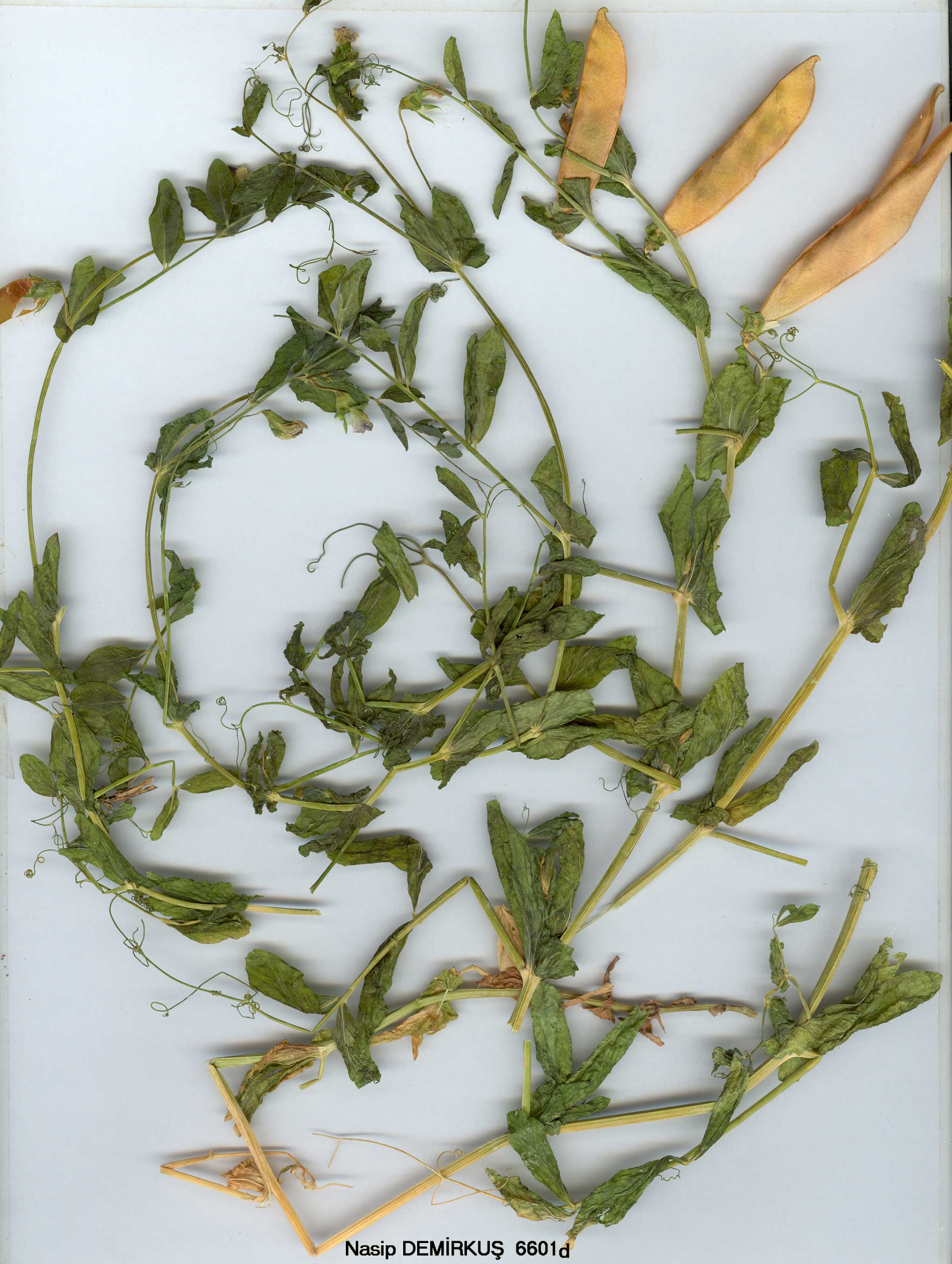| Fabaceae |
|---|
Pisum L. |
| P. sativum L., Sp. PL 727 (1753). Govorov in Bull. Appl. Bot. PL Breed. (Leningrad) 19(2):517 (1928); Zhukovsky, Turquie Agricole, 366 (1933). Glabrous, glaucous annual, stems 10-200 cm, often climbing. Leaflets 1-4-paired, entire or dentate; stipules 1.5-8 cm long, obliquely ovate, dentate at least below, rounded and semi-amplexicaul at base; tendrils branched. Peduncle ¼-4 x as long as the stipules, 1-3-flowered, with or without a short awn, usually larger than the leaflets. Flowers 16-30 mm, with a broad lilac standard and darker reddish-purple wings, or flowers white. Calyx 8-15(-20) mm; teeth sub-equal, longer than tube, ovate-lanceolate,' ± acuminate, herbaceous. Legume oblong-linear or linear, 40-70(-150) x 7-17(-30) mm; seeds 3-10, at least 5 mm diam., testa densely papillose, or smooth or wrinkled. Fl. 4-5{-6). 1. Seeds densely papillose; peduncles ¼-4 x as long as stipules; flowers bi-coloured; legumes 7-12 mm broad (wild) subsp. elatius 2. Flowers 20-30 mm; legumes (50-)55-70 x 9-12 mm; leaflets (l-)2-4-paired, ovate-elliptic, entire or subdentate; stems 30-200 cm 3. Peduncles l-2(-3)-flowered, 2-4 x as long as stipules; leaflets (2-)3-4-paired; stems 60-200 cm; flowers (20-)25-30 mm var. elatius 3. Peduncles 1-flowered, ¼-l(-l½) x as long as stipules; leaflets (l-)2(-3)-paired; stems 30-60 cm; flowers c. 20-22 mm var. brevipedunculatum 2. Flowers 15-18 mm; legumes 40-45 x 7-8(-ll) mm; leaflets 1-3-paired, elliptic or elliptic-obovate, usually ± dentate; stems 10-30 cm, more slender var. pumilio 1. Seeds not papillose, but smooth or wrinkled; peduncle ½-2 x as long as stipules; flowers white or bicoloured; legumes 12-17(-30) mm broad (cultivated, spontaneous or wild) subsp. sativum 4. Flowers bicoloured; stipules with a reddish spot; seeds 4-8 mm. often angled and blotched var. arvense 4. Flowers white; stipules without a reddish blotch; seeds usually larger, globose and unblotched var. sativum subsp. sativum. Ic: Villax, Cult. PL Fourr. Médit. Occid. t. 146 (1963). var. sativum. Ic: Reichb., Ic. Fl, Germ. 22: t. 270 (1903). Field crop. Described from Europe (Hb. Cliff.! Hb. Linn. 903/1!). A2(E) Istanbul: Pisani, Therapia, 29 vi 1890, Azn.! Bahçeköy, 9 vi 1892, Azn.! C5 Içel: Çukurova. Çakuli Köy nr. Tarsus, Beaver T203. Cosmopolitan. Cultivated for its edible seeds (field pea, Turkish bezelye) and represented by numerous cultivars. var. elatius. Syn: P. elatius Bieb., Fl. Taur.-Cauc. 2:151 (1808). Ic: Reichb., Ic. Fl. Germ. 22: t. 268 (1903); Fl. Armenii 4 : t. 81 (1962). Rocky or grassy slopes, ruins, field margins, s.1.-1700 m. Wild. Type: [Georgia] Iberia, Steven. Turkey-in-Europe, Outer Anatolia, Islands. A1(E) Çanakkale: Gelibolu, Jam Baz De., Ingoldby 154! A1(A) Çanakkale: Erenköy, Dumbrek valley, Sint. 1883: 348! A2(E) Istanbul: Rumelihisari, 20 v 1918, B. Post! A2(A) Istanbul: valley of Büyük Göksu, 2 v 1917, Azn.! A4 Kastamonu: Inebolu, nr. Ibras, Sint. 1892: 4059. A5 Amasya: Çengelhan, nr. Amasya, 600 m, Bornm. 1889:248. A8 Çoruh: Artvin (Grossheim: map 527). A9 Çoruh, Ardanuç (Grossheim: map 527). Bl Izmir: Ilica, Soğan dere, 200-300 m, Bornm. 1906:9427. B5 Adana: Gürümze, 1700 m, Kotschy 154! Cl Muğla: nr. Selimiye, 170 m, D. 40727! C2 Aydin: d. Karacasu, Aphrodisias (Geyre), 600-700 m, D. 41610! C3 Antalya: Kirkoz,, 300 m, Tengwall 332! C4 Içel: Anamur to Silifke, Karamanoğlu 21/1961! C5 Hatay: El Ourdou (Yayladağ), 420 m, Samuelsson 5292. C6 Hatay: 30 km from Antakya, 800 m, Dinsmore 20337! Is: Samos, W of Marathokampos, Rech. 4073. S. Europe, Crimea, N. Africa, Cyprus, W. Syria, Caucasia, N. Iran. Medit. element ? |
 ASCHERS_ ET GRAEBN_ var_ pumilio MEIKLE _jpg.jpg)
 ASCHERS_ ET GRAEBN_ var_ pumilio MEIKLE_jpg.jpg)

